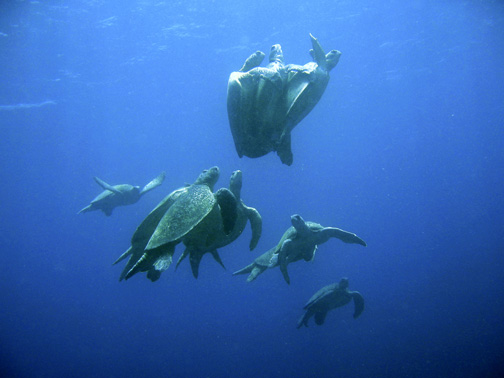Wallace J. Nichols is a sea turtle biologist and marine conservation activist affiliated with the California Academy of Sciences, Ocean Revolution, and the Sea Turtle Network, among others. J’s blog is dedicated to new beginnings and fresh ideas, especially among young people.

There should be a sign posted along beaches of the world during a certain season: “WARNING: Enter water at your own risk”. I’m not speaking of extreme undertow or heavy shore-break. Not water quality, or red tide concerns. Nor warnings against poisonous jellyfish. These are all important water safety concerns, but I am referring to something else, something almost as dangerous. I am talking about the distinctly unique experience of being in the water with green turtles during mating season.
On a recent research expedition to Indonesia, we had the opportunity to sneak up on a pair of mating green turtles. It’s a sight to behold for its grace, beauty, ancient simplicity and…well, its ruggedness.
Green turtle mating happens in the water. Often in beautiful turquoise tropical water, near idyllic sandy beaches backed by bent palm trees. Add a Barry White soundtrack and a couple of mai-tai’s and it’s honeymoon city.
A bit of an aquatic turtle dance precedes copulation. Males nip and bump and eventually mount the female. To a biologist, it’s kind of like watching two boulders with flippers getting it on. Other than the female guiding the rigid ball of turtle to the surface to breath, there’s not much apparent movement during the act. Throughout the mating season males maintain high activity levels, presumably associated with locating and mating with as many females as possible to maximise their reproductive output (Hays et al., 2001).
The male turtle hangs on to the front edge of the female’s shell with a pair of large recurved claws. The male’s tail has another “claw” at the end. This facilitates a sturdy three-point attachment, whereby the penis can enter the cloaca of the female. Attempts to knock male #1 off of the female turtle by males #2 through 17 are frequent, severe and generally unsuccessful. Physical damage to both members of the copulating pair is common.
Occasionally, a horny, excluded male will mount the pair (this is going absolutely nowhere for male #2). Further on, another male may join the fun and attach his tripod of claws to male #2. So on and so on, as a chain of turtle love and hormones extends to four or more. When this sort of thing happens with earthworms in the garden, it’s merely curious. With 400 pound sea turtles its a bizzarely orgyastical circus of ancient oceanic sexuality. Bring your camera.
But it gets better. Male turtles are known to hang on (and in) for hours on end. For 2, 8, 12 hours…or more.
Through the years, this has been impressively noted by the males of the human species. I’m willing to bet this is somehow related to the belief that turtle eggs are aphrodisiacs beyond compare. Incidentally, and perhaps not unexpectedly, the dried and shaved green turtle penis is considered wickedly potent when added to booze, a sort of Viagra with King Kong strength. First hand experience tells me that neither are particularly effective.
Back in the ocean, males are the pursuers, the females are the deciders. An unreceptive female will press rear flippers together and/or rest on the sea floor, prohibiting access to her cloaca and eggs. That leaves the males swimming in circles around her, biting each other, mounting each other, mounting logs or buoys or…(back to the warning signs on the beach)…you.
A horny male green turtle will aggressively mount a swimmer, snorkeler or diver. Expect a big claw on each shoulder and a large tail around underneath. Attached to 400 pounds of reptile ready for some all day and all night lovin’. Consider yourself warned.
Cue soundtrack, Marvin Gaye, “Let’s get it on“…and on, and on, and on….
Citation:
Hayes, G.C., Broderick, A.B., Glen, F., Godley, B.G., & Nichols, W. J. (2001). The movements and submergence behaviour of male green turtles at Ascension Island Marine Biology, 139 (2), 395-400 DOI: 10.1007/s002270100580






Wow, J. Thanks for the warning! It’s amazing what nature does. The female needs all the eggs she can lay so be sure enough of her offspring survive. It seems this helps ensure the survival rate.
Case in point…a report by Brian Bowen:
Sexual Harassment By A Male Green Turtle (Chelonia mydas)
http://www.seaturtle.org/mtn/archives/mtn117/mtn117p10.shtml
“These are large powerful animals, with potential to inflict injury or even drown an unsuspecting swimmer.”
Hi J – I liked reading this – could hear the music in the background, had a smile on my face and a chuckle… just imagining the turtle on the bottom looking up staring the males down… don’t you dare come near me ;) beams***
OK – it’s confirmed! In my next life I’m definitely coming back as a green sea turtle lol. Excellent posting – thnx.
want to be a sea turtle!!!
they do it for 12 hrs or more? awesome!!!!